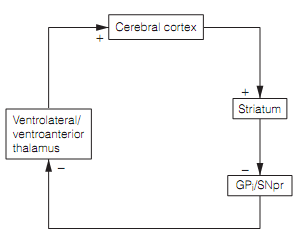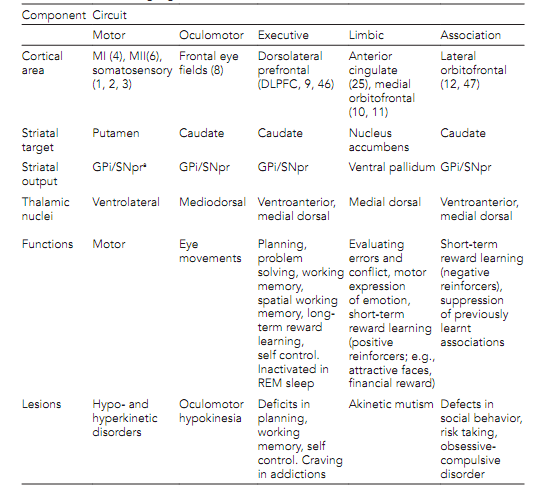Parallel processing in basal ganglia
Somatotopic representations present in all structures of the basal ganglia, apart from the SNpc. The outcome of the basal ganglia to the thalamus begins somatotopic maps there. Therefore, the connectivity of basal ganglia circuits permits highly precise and well-focused behavioral outcomes. The somatotopic maps in the thalamus generated by the basal ganglia are split from those generated by the cerebellum.
The basal ganglia are significant in many functions as well the typical motor activities. There are five parallel circuits broadly such that as shown in figure, each getting corticostriatal inputs from a region of frontal cortex and planning back to the similar area by way of precise basal ganglia areas and thalamic nuclei. These are termed to as basal ganglia-thalamocortical circuits as shown in table below. Separately from the motor circuit there are circuits related with eye movement, executive functions, the limbic system, and lateral orbitofrontal cortex. The limbic circuit, dissimilar the others, goes by way of the ventral striatum (i.e., nucleus accumbens), that is part of the dopamine motivation system, instead of the caudate or putamen. The limbic circuit consists of medial orbitofrontal cortex. The orbitofrontal cortex (OFC) appears to be implicated in fast stimulus-reinforcement learning and its reversal, with the medial OFC being more anxious with positive reinforcers and the lateral OFC with negative reinforcers. In one model the OFC is the brain structure answerable for measuring the hedonic quality of stimuli that is crucial for goal-directed behaviors like eating and drinking. Both the limbic and lateral orbitofrontal circuits are significant in emotion.


Table: Parallel basal ganglia-thalamocortical circuits
As the circuits are all wired in much similar way it is probable that they all perform the similar computations. The various outcomes of the operation of each of the circuits based on the cortical areas they are associated to, and the contexts in which they are activated. Fascinatingly basal ganglia disorders can generate deficits in thought procedures not unlike to those which affect movement.